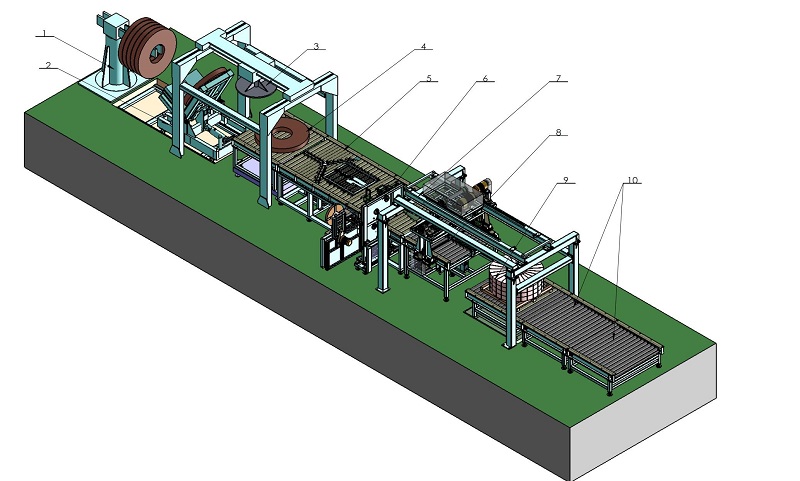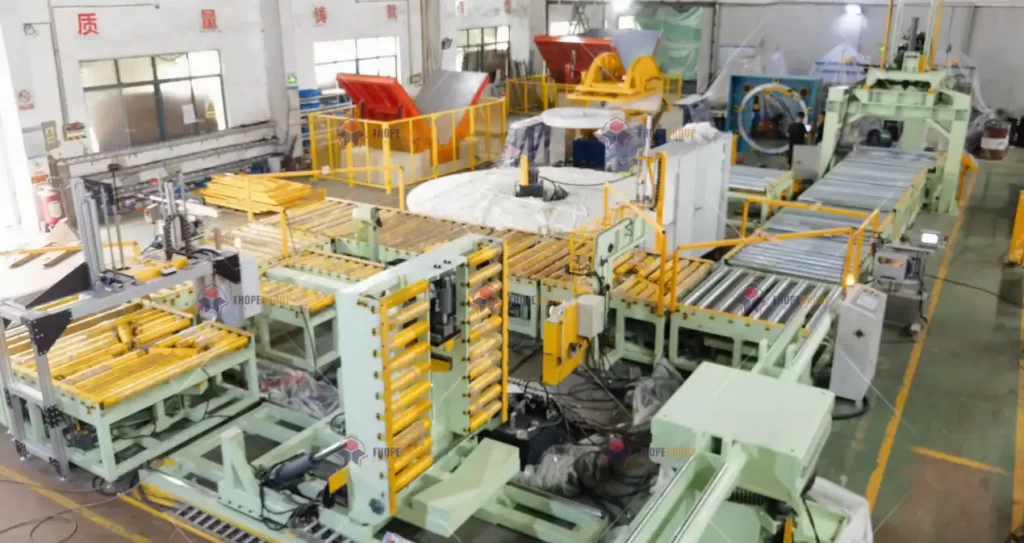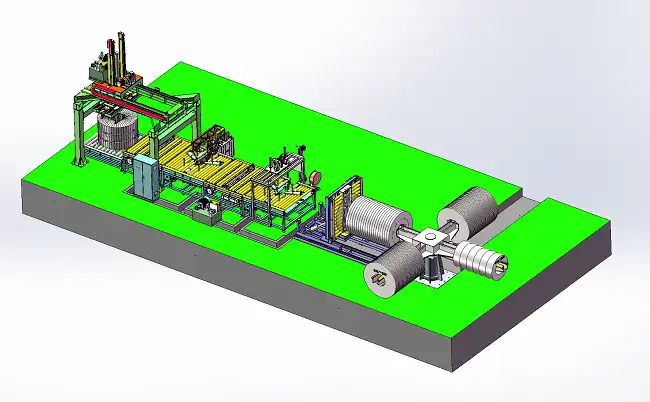In the world of industrial manufacturing, downtime is the enemy. Every second a machine stands idle is a second of lost revenue. That's why finding new, innovative ways to streamline processes is not just beneficial—it’s essential. Our journey began when our team faced a daunting challenge: reducing downtime in our steel coil packing line, which was notorious for bottlenecks, equipment malfunctions, and inefficiency.
After months of intensive research and development, we managed to implement a custom solution that ultimately reduced downtime by 30%. The following case study walks you through the steps we took, the challenges we faced, and how this transformation was achieved.
It didn't happen overnight, and it certainly wasn't easy. But by analyzing our existing processes, collaborating with experts, and experimenting with different technologies, we found a solution that not only met but exceeded our expectations. Here's how we did it.
When we first set out to optimize our steel coil packing line, it was clear that the problem wasn’t singular. Multiple factors contributed to the inefficiency, and they needed to be addressed holistically. We began by mapping out every minute of downtime, categorizing the reasons, and identifying the most significant pain points. This diagnostic phase was crucial. Without it, we risked treating the symptoms without addressing the root cause.

The next step was to explore different types of automation and customization. Off-the-shelf solutions weren’t going to cut it. Our facility had specific needs, and the standard equipment available on the market wasn’t flexible enough to accommodate them. That’s when we decided to design a custom packing line, tailored to our exact specifications.
Table of Contents
- What were the initial challenges we faced?
- How did we approach the problem?
- What were the key innovations in our solution?
- How has this transformation impacted our operations?
1. What were the initial challenges we faced?
1.1 Identifying bottlenecks in the existing system
The first step in solving any problem is understanding it fully. In our case, we had to take a long, hard look at the existing steel coil packing line and figure out why it was causing so much downtime. The most glaring issue was the sheer number of manual interventions required. Workers had to frequently stop the line to adjust equipment, fix jams, or reset machinery.
Every stop, no matter how short, added up. What seemed like minor hiccups when viewed individually were actually costing us hours of lost productivity every day. And while our team was quick to identify problems and get the line running again, the constant interruptions were unsustainable. [sub-heading featured image]
1.2 The cost of inefficiency
Downtime in manufacturing doesn’t just affect output—it impacts the entire supply chain. Delays in packing meant delays in shipping, which in turn meant late deliveries to customers. This ripple effect was hurting our reputation and driving up operating costs. We couldn’t afford to let this continue.
It became clear that reducing downtime wasn’t just about fixing the packing line. It was about improving the overall efficiency of our operations, from production to delivery.
1.3 How we prioritized our challenges
Once we had a clear understanding of the problem, the next step was to prioritize the challenges. Not every issue could be solved at once, so we had to identify the most critical bottlenecks. The packing line was complex, with multiple moving parts, but through our analysis, we discovered that the biggest issues were related to the manual handling of coils and the malfunctioning of outdated equipment.
By focusing on these two areas first, we knew we could make the most significant impact. We began by designing automated solutions that would reduce the need for manual intervention and upgrading the equipment to more reliable, modern machines. The goal was to create a more self-sufficient system—one that could operate with minimal human interference, reducing the chances of errors and breakdowns.
2. How did we approach the problem?
2.1 Mapping the process and identifying inefficiencies
Our first major step was conducting a thorough analysis of the entire steel coil packing process. We mapped each stage from start to finish, identifying where delays and inefficiencies occurred most frequently. This was no small task, as the packing line involved multiple machines, each with its own set of requirements and potential failure points.
We used real-time data from the shop floor to track downtime events. This data allowed us to pinpoint exactly when and where stoppages happened, whether due to machine failure, manual interventions, or misaligned steel coils. By reviewing this data daily, our team built a comprehensive picture of the packing line’s performance.

What we found was staggering: nearly 70% of downtime was caused by equipment malfunctions, with the rest stemming from manual interventions that could be automated. This revelation set the stage for our next move—automation.
2.2 The need for automation and custom solutions
Automation seemed like the obvious answer, but it wasn’t as simple as just purchasing a new machine. Our steel coil line had unique requirements that didn’t align with the standard equipment on the market. Off-the-shelf solutions would have required us to make compromises, something we weren’t willing to do.
Instead, we worked closely with a team of engineers to develop a custom system that addressed our specific needs. The goal was to create a packing line that could handle various coil sizes, adjust automatically, and reduce the need for manual supervision. [sub-heading featured image]
2.3 Implementing our custom solutions
The design of the new automated system was tailored to our operations. We incorporated sensors and programmable logic controllers (PLCs) that allowed for real-time adjustments based on the size and weight of each coil. This eliminated the need for workers to manually intervene whenever there was a change in coil specifications.
One of the most significant upgrades we made was in the area of coil wrapping. Previously, wrapping coils required constant attention to ensure the packaging material was applied correctly. Now, with our new automated wrapping system, the machine adjusts itself to ensure a consistent, secure wrap every time, regardless of coil size or shape.
By automating these key aspects of the process, we were able to drastically reduce human error, speed up the packing time, and eliminate one of the biggest sources of downtime.
3. What were the key innovations in our solution?
3.1 The integration of smart technology
The backbone of our new packing line was smart technology. By integrating sensors and advanced PLCs, we gave the system the ability to monitor itself and make adjustments in real-time. This wasn’t just about automation—it was about creating a system that could think and adapt on the fly, minimizing the need for human intervention.
For example, the sensors could detect when a coil was slightly misaligned and automatically correct the issue before it became a problem. In the past, this type of misalignment would have required a worker to stop the line and manually fix the issue, costing precious time. Now, the system corrects itself without any downtime.
3.2 Upgrading equipment for reliability
One of the biggest sources of downtime in our old system was equipment failure. The machines we were using were outdated and prone to breakdowns, which meant frequent stops for repairs. To address this, we invested in more reliable, modern equipment designed specifically for our industry.
The new machines were not only faster but also more durable. We worked with manufacturers to customize them to our needs, ensuring they could handle the heavy workload of a steel coil packing line without breaking down. This investment paid off almost immediately, as the number of equipment-related stoppages dropped dramatically. [sub-heading featured image]
3.3 How automation reduced human error error is inevitable in any manual process, but in our case, it was a significant contributor to downtime. Workers had to constantly monitor the packing line, stop it to make adjustments, and intervene when things went wrong. This process was not only time-consuming but also prone to mistakes.
With our new automated system, many of these tasks were taken out of human hands entirely. The machines could now handle most of the adjustments on their own, which reduced the chances of error and the need for manual intervention. This not only sped up the process but also improved the overall quality of the packed steel coils, as the system could consistently apply the right amount of force and material for each coil.

4. How has this transformation impacted our operations?
4.1 The immediate benefits of reduced downtime
Once the new system was fully implemented, the impact was immediate. Downtime dropped by 30%, which translated into significant cost savings and increased productivity. The packing line was no longer a bottleneck in our process, allowing us to meet our production targets more consistently.
Beyond the numbers, the reduction in downtime also had a positive effect on our workforce. With fewer manual interventions required, workers were able to focus on more value-added tasks, such as quality control and process optimization. This helped to boost morale and reduce the strain on our team.
4.2 Long-term improvements in efficiency
The benefits of the new system weren’t just short-term. Over time, we noticed that the overall efficiency of our operations continued to improve. The automated system allowed us to scale up production without needing to hire additional workers or invest in more equipment.
In fact, the efficiency gains were so significant that we began exploring how we could apply this same approach to other areas of our plant. The success of the steel coil packing line became a blueprint for future improvements across our entire operation. [sub-heading featured image]
4.3 The role of customization in our success
One of the key takeaways from this project was the importance of customization. If we had simply purchased an off-the-shelf solution, we wouldn’t have seen the same level of success. By taking the time to understand our unique challenges and working with experts to design a custom solution, we were able to create a system that was perfectly suited to our needs.
This experience taught us that while customization can be more expensive upfront, it often pays off in the long run. In our case, the investment in a customized packing line led to significant savings and efficiency gains, which more than justified the initial cost.
5. What were the long-term effects of the new system?
5.1 How did we monitor ongoing performance?
Once the new system was operational, we knew that continuous monitoring would be essential to maintain and improve performance over time. We implemented an advanced tracking system that collected real-time data on every aspect of the packing line, from machine performance to coil handling and wrapping efficiency.
This data allowed us to track the system's overall health and spot any emerging issues before they could cause downtime. By regularly reviewing performance metrics, we could also tweak the system to get even more out of it. For instance, by adjusting the parameters of the wrapping system, we were able to reduce material waste by 5%, further increasing cost savings.
This proactive approach to monitoring meant that we could address problems before they escalated, keeping downtime to a minimum and ensuring the system continued to perform at its peak. [sub-heading featured image]
5.2 The impact on our workforce
The introduction of the new system didn’t just improve our operations; it also had a profound effect on our workforce. With fewer manual interventions required, our employees were freed up to focus on more strategic tasks. Instead of spending their time fixing problems and restarting machines, they could now work on optimizing the line, improving quality control, and innovating further processes.
This shift allowed us to retrain some of our team members, giving them new skills and responsibilities. The automation didn’t lead to layoffs, as some might assume—it actually empowered our workers by giving them more meaningful roles within the company. This led to higher job satisfaction and a more motivated workforce, which, in turn, contributed to even greater operational efficiency.
5.3 The financial benefits of reduced downtime
The financial impact of reducing downtime by 30% was significant. Not only did it result in higher productivity, but it also saved us a considerable amount of money on labor costs, equipment repairs, and lost production time.
The investment in automation and customized equipment paid for itself within the first year, and we continue to see financial benefits today. With a more efficient packing line, we’ve been able to take on additional orders, meet tighter deadlines, and improve our overall profitability. [sub-heading featured image]
6. How has this transformation influenced future projects?
6.1 Applying lessons learned to other areas
The success of the steel coil packing line transformation has inspired us to look at other areas of our operation with fresh eyes. We now approach every process with the mindset that there is always room for improvement, no matter how well it currently performs. The lessons we learned from this project—about the importance of customization, automation, and real-time data monitoring—are now being applied across the board.

We are currently in the process of automating other parts of our production line, using the same principles that led to the success of the packing line. By continually refining our processes and investing in cutting-edge technology, we believe we can continue to drive down operating costs and improve our overall efficiency.
6.2 Scaling up production with minimal investment
One of the most exciting outcomes of this project has been our ability to scale up production without needing significant additional investment. The automation we implemented has given us the flexibility to increase output without adding new shifts or hiring more workers.
This scalability has been a game-changer for our business. With the ability to meet growing demand more efficiently, we’ve been able to expand into new markets and take on larger contracts, all while keeping our costs under control. The packing line transformation has positioned us for long-term growth, and we’re excited to see where it takes us next.
6.3 The role of continual improvement
While we’re thrilled with the results we’ve achieved so far, we know that the work doesn’t stop here. Continuous improvement is now a core part of our company culture. We regularly review the performance of the packing line and look for ways to make it even more efficient.
Whether it’s through small tweaks to the system or larger investments in new technology, we’re committed to staying ahead of the curve. Our goal is not just to maintain our current performance but to keep pushing the boundaries of what’s possible in steel coil packing—and beyond.
Conclusion
The transformation of our steel coil packing line has been nothing short of revolutionary. By reducing downtime by 30%, we’ve not only increased our productivity and efficiency but also improved the overall quality of our operations. The key to our success was a combination of detailed analysis, custom solutions, and the integration of smart technology.
This project has shown us the value of investing in automation and customization, and it has set the stage for future innovations across our entire facility. We’ve learned that when you take the time to understand your unique challenges and work with experts to develop tailored solutions, the results can exceed your expectations.
